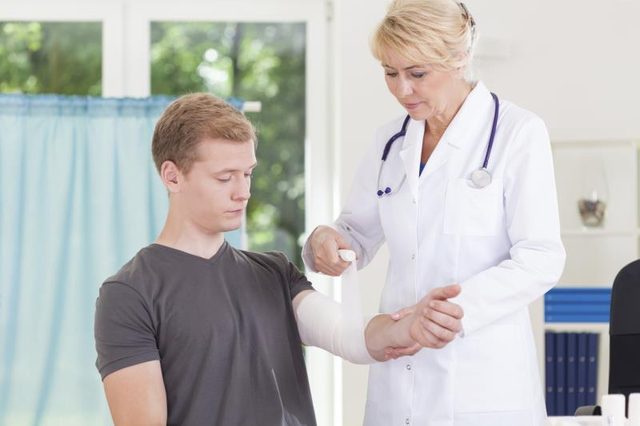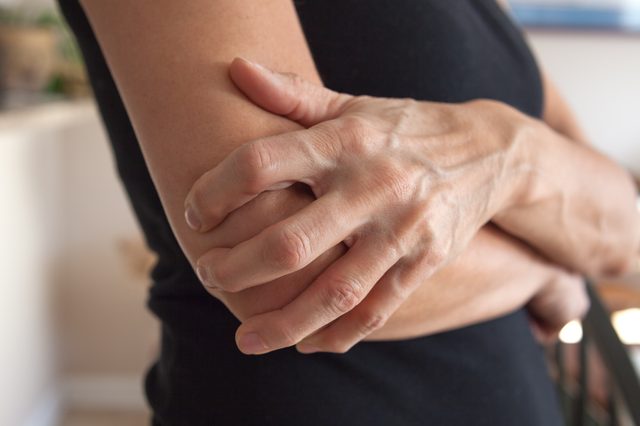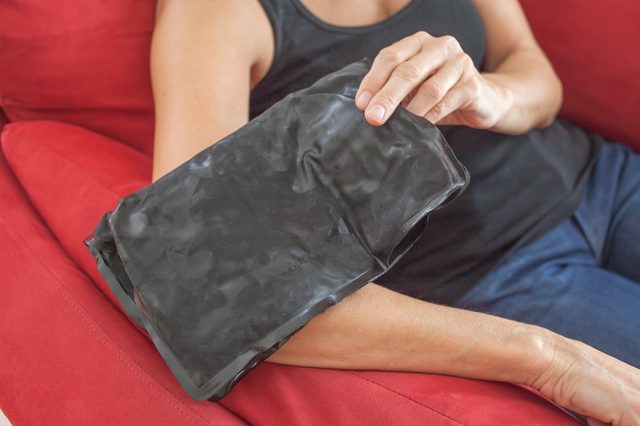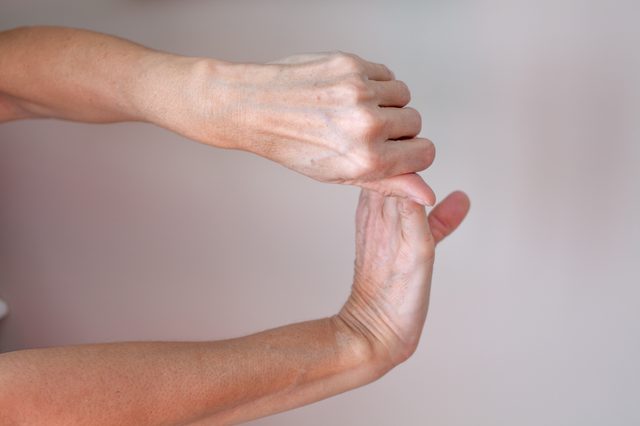Torn Ligament or a Tennis Elbow?

Anyone who has ever experienced an elbow injury knows how excruciating and inconvenient it can be. Even the smallest task, such as tying your shoes, can seem impossible when every bend of the arm causes pain. Whether you suspect you're suffering from tennis elbow or a torn ligament, it's always wise to see your doctor as soon as you feel the first twinge of elbow pain.
When It's Tennis Elbow
Despite its name, tennis elbow doesn't only affect tennis players. This injury occurs when the tendons -- the tissue that connects muscle to bone -- in your elbow become inflamed. The inflammation is generally the result of repetitive motions, such as hammering nails, chopping meat or, yes, swinging a tennis racket. The pain caused by tennis elbow should come on gradually rather than as the result of an accident. If you have tennis elbow, you will likely feel burning or pain at the outside of the elbow and you'll likely have difficulty making a fist or gripping things.
Treatments for Tennis Elbow
When you start to develop symptoms of tennis elbow, rest your elbow until you can get in to see your doctor. She may do x-rays to rule out any other possibilities, such as arthritis. Once she's determined you have tennis elbow, she'll recommend a few courses of treatment. You'll need to take a break from whatever activities caused the injury, and she may also give you medication to bring down the swelling or recommend that you wear a brace or visit a physical therapist. Most instances of tennis elbow don't require surgery. According to the American Academy of Orthopaedic Surgeons, between 80 and 95 percent of tennis elbow cases can be successfully treated without surgery.
How to Get Rid of Tennis Elbow

Sharp pain and inflammation in your elbow can be a sign of tennis elbow. Named for the frequency with which this type of injury affects tennis players, tennis elbow is a strain injury in the outer tendon of the elbow. Although roughly half of all tennis players suffer from tennis elbow at some point, the injury is common among all non-tennis players, as well. Only 5 percent of those with tennis elbow at any given time are tennis players. Depending on the severity of the injury and how you try to get rid of it, tennis elbow can last anywhere from three weeks to several years.
Step 1
Stop using your arm, moving it as little as possible until the pain completely recedes. Avoid lifting objects whenever possible. Most chronic tennis elbow injuries occur when individuals try to continue working through the pain or do not let the injury fully heal. With proper care, tennis elbow usually disappears after a few weeks.
Step 2

Ice your elbow at 15 minute intervals three to six times each day. This helps reduce swelling and inflammation. Keeping the swelling down accelerates the healing process.
Step 3

Wear a supportive brace that applies some compression to your arm's muscles and tendons. The brace should have an elbow joint hole to help keep the brace stable as you move your arm.
Step 4

Stretch your wrist to its full range, performing the stretch with an empty hand and holding a small cup. Bend your wrist as far back as you can, providing slight pressure with your other hand. Then bend your wrist forward so that your palm moves towards your inner arm. Then repeat this step while holding a small cup in the hand being stretched.
Step 5

Talk to your doctor about potential therapy or other treatments, which can include physical therapy, electrotherapy, ultrasound or laser treatment to heal your tennis elbow.
Tips
Take over-the-counter pain relievers, following the manufacturer's directions, or your doctor's recommendations.
How to Wear a Tennis Elbow Arm Band

Tennis elbow straps or braces are a frequently prescribed orthopedic device used to reinforce the muscles damaged by tennis elbow. According to MayoClinic.com, tennis elbow, or lateral epicondylitis, is commonly treated with the help of straps and braces that can reduce the impact regular activities have on injured tissues. While the vast majority of tennis elbow cases do not require surgery or corticosteroid treatment to completely heal, a tennis elbow arm band or strap may be recommended to help protect the lateral elbow muscles from stress as you heal. Consult your doctor to decide whether this device is recommended for your particular situation.
Step 1
Rest your elbow on a pillow or cushioned surface to reduce the stress of applying the tennis elbow arm band. Rub your lateral elbow muscles with your fingers until you locate the spot that appears to be the most painful.
Step 2
Measure 10 cm down your forearm from that spot with the help of a ruler or tape measure. Place the brace component of the arm band directly on the measured spot on your forearm and release the Velcro strap so that it hangs down from your arm. The brace should rest on the top of your forearm with the strap resting on the outside or “pinky finger" side of your arm, as recommended by Sports Injury Clinic.
Step 3
Hold the brace in place as you wrap the Velcro strap under your arm and fasten it to the top of the brace component. The tennis elbow strap should be firmly wrapped around your arm in a way that reinforces the lateral muscles while not cutting off circulation.
Step 4
Press the arm splint against your forearm, should your unit comes include one, and wrap the smaller wrist strap unit around your wrist bone in the same manner as you did with the first Velcro forearm strap. Move your arm to make sure the unit stays in place; if you experience a tingling sensation or sudden paleness in your arm, loosen the Velcro straps slightly to allow more circulation.
Warnings
If severe pain symptoms continue or if you experienced your tennis injury in the last 24 hours, contact your doctor or physical therapist to make sure your tennis elbow does not require additional treatment or surgery.
When It's a Torn Ligament
Ligaments are the tissues that connect bone to bone. When these tissues tear, the injury is often called a sprain or a strain. Ligament tears come on suddenly as the result of an injury. An elbow sprain or strain may be caused by falling and landing on your arm. According to New York University’s Langone Medical Center, certain sports also put you at risk of a torn ligament. You can tear a ligament if you throw a ball forcefully, if a ball hits your elbow or if you twist your arm at an extreme angle. You may hear a popping noise, feel sharp pain and experience swelling and bruising around the elbow.
Treatment for Torn Ligaments
Torn ligaments are treated in much the same way as tennis elbow. Your doctor will likely recommend you use the RICE method of rest, ice, compression and elevation. If your elbow is only mildly sprained – you may have some swelling and discomfort but not extreme pain – these home remedies will often be enough. Surgery may also be necessary to repair a moderately or severely torn ligament, or your doctor may apply a cast to keep the elbow immobilized for several weeks or months to give the ligament time to heal.
Note – This information has been taken from different internet sources.
- Choosing a selection results in a full page refresh.
